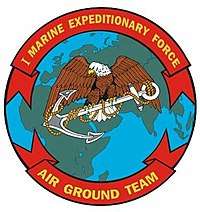I Marine Expeditionary Force
| I Marine Expeditionary Force | |
|---|---|
 I MEF insignia | |
| Active | 8 November 1969 – present |
| Country |
|
| Branch |
|
| Type | Marine Air-Ground Task Force |
| Role | Expeditionary combat force |
| Part of | U.S. Marine Forces Pacific |
| Garrison/HQ | MCB Camp Pendleton, California, U.S. |
| Engagements | |
| Commanders | |
| Current commander | Lieutenant General Joseph L. Osterman |
| Notable commanders | Gen Joseph F. Dunford, Jr., Gen Anthony Zinni, Gen Michael Hagee, Gen James T. Conway, Gen James Mattis, Gen John F. Sattler |
The I Marine Expeditionary Force ("I" pronounced "One") is a Marine Air Ground Task Force (MAGTF) of the United States Marine Corps primarily composed of the 1st Marine Division, 3rd Marine Aircraft Wing, and 1st Marine Logistics Group. It is based at Marine Corps Base Camp Pendleton.
I Marine Expeditionary Force is the largest of the three MEFs in the Fleet Marine Force and is often referred to as the "Warfighting MEF" for its consistent involvement and contributions in major armed conflicts. It is presently commanded by Lt. Gen. Joseph Osterman.[1] The deputy commander is Brig. Gen. Rick Uribe.[2]
Etymology
Pronunciation of the Roman numeral designator: As a Roman numeral the capital letter "I", representing one (1), is properly pronounced as "One." However, there are some who erroneously pronounce the number as either "First," or either intentionally, or unknowingly, pronounce it as "Eye," as in the letter "I."
The convention of using Roman numerals to designate a MEF, which is itself the Marine Corps equivalent organization to an Army corps, stems from the U.S. Army practice that began in the American Civil War, and continues today, of numbering corps (two or more divisions with supporting troops, and sometimes including separate brigades, regiments, groups, or battalions, all under a unified corps headquarters, usually commanded by a lieutenant general) with Roman numerals. Corps, themselves being the first-level sub-unit of a "field army," or a numbered, or named, army (e.g., First U.S. Army, or the Army of the Potomac).
During the First World War, the 4th Marine Brigade, as part of the U.S. Army 2nd Infantry Division, came under the U.S. Army I Corps, American Expeditionary Forces. With the expansion of the Marine Corps to six divisions and five air wings during the Second World War, the Marine Corps created two "Amphibious Corps," I Marine Amphibious Corps (later re-designated as III Amphibious Corps) and V Amphibious Corps, continuing the custom began by the Army. Modern Marine Expeditionary Forces, or MEFs (for a time known as Marine Amphibious [italics added] Forces, or MABs) continue the U.S. Marine Corps legacy as corps-equivalent organizations designated by Roman numerals.
Mission
When directed, I MEF deploys and is employed as a Marine Air Ground Task Force (MAGTF) in support of Combatant Commander (COCOM) requirements for contingency response or Major Theater War; with appropriate augmentation, serves as the core element of a Joint Task Force (JTF); prepares and deploys combat ready MAGTF’s to support COCOM presence and crisis response; and supports service and COCOM initiatives as required.
Lineage
- Activated on 8 November 1969 at Okinawa, Japan as the I Marine Expeditionary Force
- Redesignated on 18 August 1970 as the I Marine Amphibious Force (I MAF)
- Relocated in April 1971 to Camp Pendleton, California
- Redesignated on 5 February 1988 as the "I Marine Expeditionary Force"
Structure

Units
- Ground combat element: 1st Marine Division
- Aviation combat element: 3rd Marine Air Wing
- Logistics combat element: 1st Marine Logistics Group
- Command element: I Marine Expeditionary Force Information Group
- 1st Marine Expeditionary Brigade
- 11th Marine Expeditionary Unit
- 13th Marine Expeditionary Unit
- 15th Marine Expeditionary Unit
Recent service
- Operation Desert Shield – Southwest Asia – August 1990 – April 1991
- Operation Desert Storm – Southwest Asia – August 1990 – April 1991
- Operation Restore Hope- December 1992 – May 1993
- Operation Southern Watch – Iraq – January 1998 – February 1998
- Operation Desert Thunder – Iraq – February 1998 – June 1998
- Operation Enduring Freedom – Kuwait, Afghanistan – November 2002
- Operation Iraqi Freedom – Iraq – March 2003 – 2010
References
- ↑ "I Marine Expeditionary Force". Retrieved 2018-07-31.
- ↑ South, Todd (July 5, 2018). "Marine one-star cited for misusing aide, taking gifts from subordinates". Marine Corps Times.
Brig. Gen. Rick Uribe now commands I Marine Expeditionary Force at Camp Pendleton[...]
- ↑ Reynolds Baghdad, Basrah and Beyond, pg. 169.
External links
| Wikimedia Commons has media related to I Marine Expeditionary Force. |
